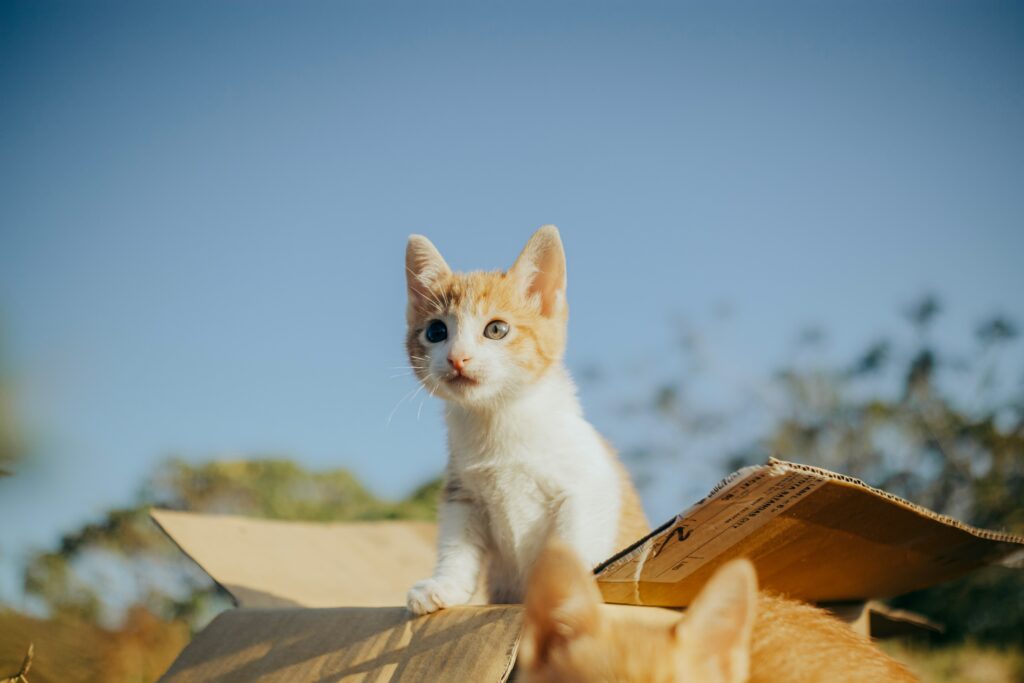Litter Training Kittens 101
Photo by Arina Krasnikova from Pexels: https://www.pexels.com/photo/white-and-orange-cat-in-brown-cardboard-box-7726316/
Kittens are the cutest. These tiny little furballs exhibit an adorably high curiosity level and possess contagious energy.
You could play with them all day long and never feel tired!
But in their quest of discovering the world, they’re highly unlikely to stay in one place. They’ll wander here and there….and also find newer places for their natural business.
Meaning, you’ll often find yourself cleaning your kitten’s droppings from the most unusual places! Sometimes under the bed, in wall corners, around their play area, their basket — typically everywhere.
Obviously, cleaning difficulties can drain out all your love and affection for these tiny little furballs real quickly. So, we highly recommend training your kitten(s) as soon as possible.
In this guide, we’ve compiled all the info that you need to get started with litter training!
When to start litter training?
In their early days, mother cats clean their kittens as need be. You might have to change the mats and maintain a clean environment for the cat family. But other than that, you won’t have to worry about any other mess.
However, once the kitten is 3-4 weeks old, it’ll start weaning. This is the right time to introduce the kitten to a litter box.
How to do it? Well, place the kitten near the litter box for about one and a half hours of food consumption. They usually feel the need to eliminate 1 – 1.5 hours after eating.
Encourage the kitten to hop into the box and explore it. Its instincts will guide the way. It’s also a good idea to place the mother cat’s litter box in close proximity, so the kittens can learn by observation.

Tips for Proper Litter Training of Kittens
We’ve briefly reviewed how you can go about litter training your kittens. Now, let’s check out some tips on how you can ease the process for yourself and your kitten.
- Choose a litter type your kitten likes.
Generally, there are three types of litter out there. They further subdivide into several categories, which means you have a plethora of options.
The three main types are:
- Wood-based or paper-based
- Silica
- Clay (clumping and non-clumping)
Cats and kittens prefer fine-grain litter types. But each feline has its unique preferences.
If you’ve been keeping cats, you can use the same type of litter for the kittens as the one you use for adult cats. However, if you’ve adopted kittens for the first time, it’s a good idea to introduce your kitten to all types of litter types (one by one) and check out its preferences.
You can buy a small pack of each litter type and pour them in separately in empty shoe boxes. Place them side by side for a few weeks and observe which litter type your kitten prefers more. Also, consider buying cheap cat litter for this purpose.
Once you have your answer, buy a bigger pack of the same litter type.
If you do not have the budget to conduct this test, here’s a list of the general preferences of most cats when it comes to litter:
- Fine grain
- Odorless
- Low dust
To make things easier for yourself, opt for a litter type that’s both odorless and odor-absorbent. It should be fast and hard clumping as well.
- Choose a box that’s easy to climb in.
Kittens will only begin using the litter box regularly if it’s in easy access. To ensure this, we recommend using a small box with shallow walls. You can even use a cardboard tray.
Also, avoid using litter boxes with lids. Your kitten will not invest time in getting your attention to open the box, every time they have to use the litter box!
- Place it in a clean corner permanently.
As mentioned earlier, kittens will look for places that are slightly away from their main area of activity (but not too far away).
Given this, it’s best to place the litter in a clean and quiet area of their main activity room.
If you have dedicated a room to your kitten, a corner opposite its bed would do best. But if you keep your kitten out in the garage or in the living room, any quiet corner with enough privacy (but easy accessibility) will work well for the kitten.
Also, make sure you place the litter box in the same spot every day. If you change places too often, it could lead to a lot of mess around the house.
Plus, avoid keeping any hazardous or misleading objects in the surroundings. For example, if there’s a laundry pile your kitten can develop bad habits.
Final Words
Before we sign off, here’s your last tip: clean the litter box every day. Do not wash it off with scrubs and detergent on a daily basis. But make sure you discard the used litter every 12-24 hours. If cleaning daily is too much, consider cleaning the pot every other day. Good luck!








